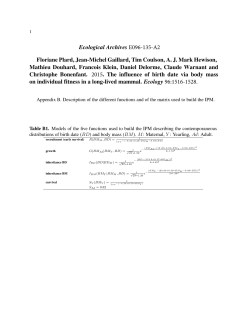
THE ADDI TION OF HYPE RTHERMIA TO
THE ADDITION OF HYPERTHERMIA TO STANDARD RADIOTHERAPY IMPROVES BOTH LOCAL CONTROL AND SURVIVAL IN INOPERABLE PELVIC TUMOURS: RESULTS OF DUTCH RANDOMIZED STUDIES V A N D E R Z E E , D . G O N Z A L E Z G O N Z A L E Z , G . C . V A N R HO O N , J . D . P . V A N D I J K , W . L . J . V A N P U T T E N , A.A.M. HART, AND P.C.M. KOPER J. van der Zee¹ , D. Gonzalez Gonzalez², G.C. van Rhoon¹ , J.D.P. van Dijk² , W.L.J. van Putten¹ , A.A.M. Hart² , and P.C.M. Koper¹ , ¹University Hospital/Dr. Daniel den Hoed Cancer Center, Rotterdam; ²Academisch Medisch Centrum, Amsterdam, The Netherlands. BACKGROUND: Experimental research has shown that hyperthermia (HT) is an effective cell killing agent especially in a hypoxic, nutrient deprived and low pH environment. Such environmental conditions are commonly found to exist within malignant tumours. Hypoxic cells are known to be relatively radioresistant. So, the combination of radiotherapy (RT) and HT will result in at least complementary effects. The existing clinical data have confirmed the experimental data: in addition to promising results from many phase I-II clinical studies, the therapeutic gain by HT in addition to RT has been proven by randomised studies in head and neck cancer, malignant melanoma, recurrent breast cancer and glioblastoma multiforme. Advanced, inoperable tumours originating from the bladder, cervix, and rectum are characterised by disappointing local control rates following RT. For the patients concerned, a locoregional failure means that the situation, in general, has become incurable. One of the reasons for the relative radioresistance may be the existence of hypoxic areas. The effect of additional HT was investigated in these patient groups. MATERIALS AND METHODS: In the Netherlands, two randomised trials investigating the effect of HT in addition to standard RT, including patients with T3 and T4 bladder cancer, IIB-distal, IIIB and IV cervical cancer, and inoperable primary or recurrent rectal cancer, have recently been closed with a total of 358 patients included. The primary objective of both studies is whether additional HT will result in an increase in local control rate. Secondary objectives are acute and late toxicity, disease free survival and overall survival. Following obtaining informed consent, patients were randomised 50% to RT alone and 50% to combined treatment. Three different systems for induction of HT were used: the B5D-2000 system, the Amsterdam 4-waveguide applicator system, and the Utrecht coaxial TEM applicator. For the three systems, similar energy distribution in human pelvic size phantoms has been demonstrated. The data from the two studies were combined. Overall, patient and tumour characteristics are evenly distributed over the two treatment arms, except tumour stage which appears somewhat less favourable in the combined treatment arm. Radiotherapy was applied according to standard schedules, including brachytherapy for cervical cancer. Patients from institutes without hyperthermia facilities were irradiated at the referring institute. Hyperthermia was given once weekly, during the period of external RT, to a total of 5 treatments. The duration of each HT treatment was 60 minutes, following a heating period of maximum 30 minutes. There are no significant differences between the two treatment arms concerning the total RT doses applied. A relatively large number of patients in the combined treatment arm has not received HT treatments: 12% of the patients with cervical cancer and 17% of the patients with bladder cancer. Two patients in the RT-alone arm did receive HT-treatments. The analysis of results was done on the basis of the intention to treat principle. RESULTS: The preliminary results including total 298 patients with sufficient follow-up time show a significant improvement in local control rate by additional HT, from 37% to 58%. The addition of HT also resulted in better overall survival. At 3 years follow-up this was 24% following RT, and 30% following combined treatment. The effect of HT was most impressive in the group with cervical cancer (n=99), with significant improvement of both local control (+34) and overall survival (+29 at 3 years follow-up). In bladder cancer (n=85), the improvement in local control was temporary and not resulting in a better survival. In rectal cancer (n= 114), the improvement in local control seemed less and was not significant. The available data show no indication for enhanced radiation toxicity. CONCLUSIONS: This study has shown that the addition of hyperthermia to standard radiotherapy of inoperable pelvic tumours improves both local control and survival. From the results of subgroup analysis it was concluded to offer combined treatment standard to patients with tumours of the uterine cervix, stages IIB-distal, IIB and IV, and to develop new study protocols for patients with bladder and rectal cancer.
© Copyright 2025





















